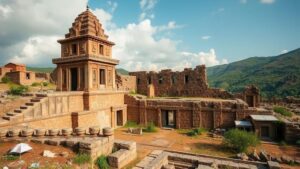Exploring the mysterious rock formations of Madagascar’s Avenue of the Baobabs.
Exploring the Mysterious Rock Formations of Madagascar’s Avenue of the Baobabs
Madagascar is home to an incredible variety of natural wonders, one of which is the iconic Avenue of the Baobabs. Located in the Menabe region, near the town of Morondava, this striking avenue features a collection of majestic baobab trees (Adansonia grandidieri) that are estimated to be over 800 years old. This unique landscape, often described as otherworldly, has attracted tourists and researchers alike to explore its mysteries and ecological significance.
The Geography and Climate
The Avenue of the Baobabs is situated along a dirt road that connects Morondava to Belon’i Tsiribihina. It stretches for about 260 meters and features towering baobab trees that can reach heights of up to 30 meters (about 98 feet). The climate in this region is semi-arid, characterized by a dry season from April to October and a rainy season from November to March. This climate plays a crucial role in the growth and longevity of the baobabs.
Historical Significance
The baobabs have cultural significance for local communities, who regard these trees as sacred. Historically, the baobab trees were an important resource for the Malagasy people, providing food, water, and materials for building. In fact, the fruit of the baobab (often referred to as monkey bread) is high in vitamin C and is used both in traditional dishes and for medicinal purposes.
Unique Ecosystem
The Avenue of the Baobabs is more than just a picturesque landscape; it is part of a delicate ecosystem. These trees provide essential habitats for various species of flora and fauna. baobab itself is known for its ability to store large quantities of water in its trunk, allowing it to survive droughts. This water storage capacity is vital for several animals that depend on the trees for hydration during the dry season.
Tourism and Economic Impact
Tourism has become a significant component of the local economy in Morondava, with many travelers flocking to witness the stunning sight of the baobab avenue–especially during sunrise and sunset when the lighting creates a magical atmosphere. According to the Madagascar National Tourist Office, the number of visitors to this site has steadily increased over the past decade. local economy benefits from services such as guided tours, accommodation, and local crafts, creating a sustainable model for conservation.
Conservation Challenges
Despite its popularity, the Avenue of the Baobabs faces several conservation challenges. Deforestation, climate change, and agricultural expansion threaten the unique landscape. In 2007, the local government designated the area as a natural monument, highlighting the need for continued conservation efforts to protect these ancient trees. Organizations such as the Wildlife Conservation Society are actively involved in preservation initiatives, raising awareness about the ecological significance of the baobab trees.
Real-World Applications of Baobab
- Food Industry: Baobab fruit is increasingly being used in health food products due to its high nutrient content.
- Ecotourism: The avenue serves as a model for sustainable tourism, showing how natural beauty can be conserved while providing economic benefits.
- Research: The unique physiology of the baobab is a topic of ongoing research, particularly regarding climate resilience.
Actionable Takeaways
For those interested in exploring the Avenue of the Baobabs, there are several key points to consider:
- Visit during sunrise or sunset for the best photographic opportunities.
- Engage local guides to learn more about the ecological and cultural significance of the area.
- Support local businesses to help promote sustainable tourism practices.
To wrap up, the Avenue of the Baobabs is not just a collection of remarkable trees; it is a symbol of Madagascars rich natural heritage and the importance of preserving unique ecosystems for future generations. Whether you are a traveler, a researcher, or simply a nature enthusiast, this majestic avenue offers a fascinating glimpse into the beauty and fragility of our planet.


